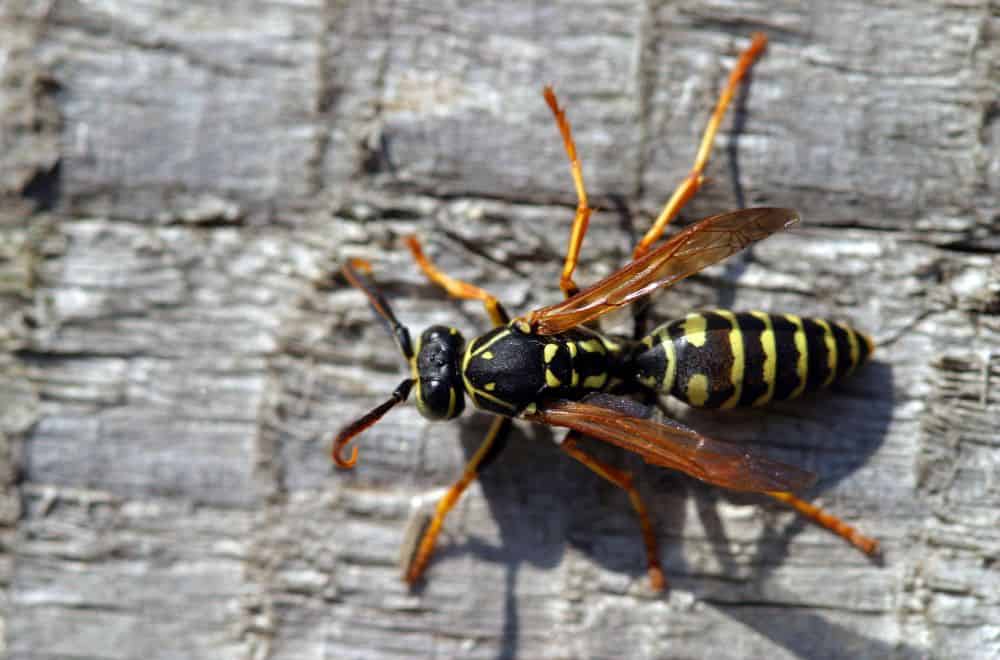Roof spaces are the most common places for wasp nesting, but you can sometimes face the question – Why do you have wasps in your loft but no nest? Be aware that there is no chance these insects fly around without a place to lay eggs.
Therefore, you should look more carefully and check even the weirdest spaces, like under-roof tiles and along the gutter line. Once you locate the nest, it is time to find the most appropriate way to eliminate these insects and prevent them from re-coming.
Wasp types |
||
| Type | Size | Color |
| Yellow Jackets | 0.50 to 0.70 inches
(13 – 18 mm) |
Yellow-black striped pattern |
| German Yellow Jacket | 0.50 inches (13 mm) | Yellow-black pattern |
| Southern Yellow Jackets | 0.50 inches (13 mm) | Yellow-black striped pattern |
| Paper wasps | 0.75 to 1.50 inches
(19 – 38 mm) |
Yellow, red, black, or brown |
| Northern Paper wasps | 0.50 to 1.50 inches
(13 – 38 mm) |
Orange, reddish-brown, or dark red, sometimes with yellow or red stripes |
| European Paper wasp | 0.75 to 1.50 inches
(19 – 38 mm) |
Red-brown or brown with yellow markings |
| Hornets | 1 to 2 inches
(25.4 – 51 mm) |
Chestnut-brown with yellow-orange stripes |
| European Hornets | 1 to 1.50 inches
(25.4 – 38 mm) |
Brown with dull yellow-orange stripes |
| Bald-faced Hornets | 0.75 to 1
(19 – 25.4 mm) |
Black with white markings |
| Great Black wasps | 0.87 to 1.10 inches
(22 – 28 mm) |
Deep black |
| Spider wasps | 0.20 to 1.38 inches
(5 – 35 mm) |
Black or brown |
| Cuckoo wasps | 0.08 to 0.87 inches
(2 to 22 mm) |
Bright metallic green or purple |
| Mud Daubers | 0.50 to 1 inch
(13 – 25.4 mm) |
Black, sometimes with pale markings or a blue metallic luster |
| Blue-winged wasps | 0.80 to 1 inch
(20.3 – 25.4 mm) |
Black and red-brown body with two yellow spots and metallic-blue wings |
| Thread Waisted wasps | 0.50 to 1.57 inches
(13 to 40 mm) |
Black with yellow legs and metallic-blue or clear wings |
| Cow Killer wasps | 0.75 inches (19 mm) | Black body covered with bright reddish-orange hair |
| Cicada Killer wasps | 1.50 to 2 inches
(38 – 51 mm) |
Black or dark brown with yellow markings |
| Braconid wasps | 0.03 to 0.37 inches
(0.8 – 9.4 mm) |
Yellow, brown, red, or black |
| Potter wasps | 1.18 inches (30 mm) | Black or brown with a yellow, orange, or red pattern |
| Four-toothed Mason wasps | 0.70 inches (18 mm) | Black with one broad ivory-colored band |
| Horntail wasps | 0.50 to 1.50 inches
(13 – 38 mm) |
Black, blue, or red-brown with ivory, yellow, and red markings |
Common Wasps Species
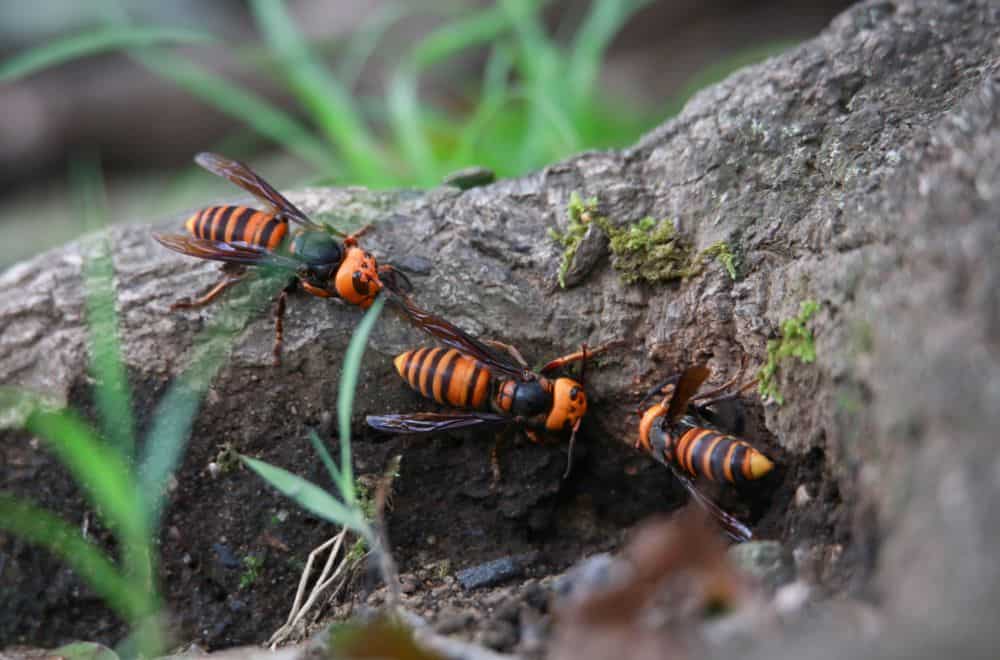
Yellow Jackets – These 0.50 to 0.70 inches (13 – 18 mm) long insects have a yellow-black body with a striped pattern. Their colonies live in nests built inside buildings or underground.
Paper wasps – Black or brown Paper wasps have 0.75 to 1.50 inches (19 – 38 mm) long bodies with recognizable yellow or red markings. They build umbrella-shaped nests in sheltered buildings throughout North America.
Hornets – You can recognize about twenty Hornet species. These insects have 1 to 2 inches (25.4 – 51 mm) long, chestnut-brown bodies with yellow-orange stripes. In most cases, they build nests on high trees and never sting unless you provoke them.
Great Black wasps – These deep black, sizable pollinators are approximately 0.87 to 1.10 inches (22 – 28 mm) long. You can find them living in holes, and they rarely sting humans.
Mud Daubers – These wasps originating in North America are 0.50 to 1 inch (13 – 25.4 mm) long and have black bodies. Sometimes, they come with pale markings or a blue metallic luster. You will never have a problem with this species since they neither build standard nests nor live in colonies.
Spider wasps – These black or brown insects reach about 0.20 to 1.38 inches (5 – 35 mm) in length. They tend to create nests in mud jugs after Mud Daubers abandon them.
Cuckoo wasps – These unique wasps have bright metallic green or purple bodies, long about 0.08 to 0.87 inches (2 to 22 mm). They lay eggs in already existing other bees’ nests.
Cicada Killer wasps – These 1.50 to 2 inches (38 – 51 mm) long black or dark-brown wasps with yellow markings feed on cicadas. They build small nests, enjoy flower nectar, and are not a threat to humans.
Why Do You Have Wasps in Your Loft but No Nest?
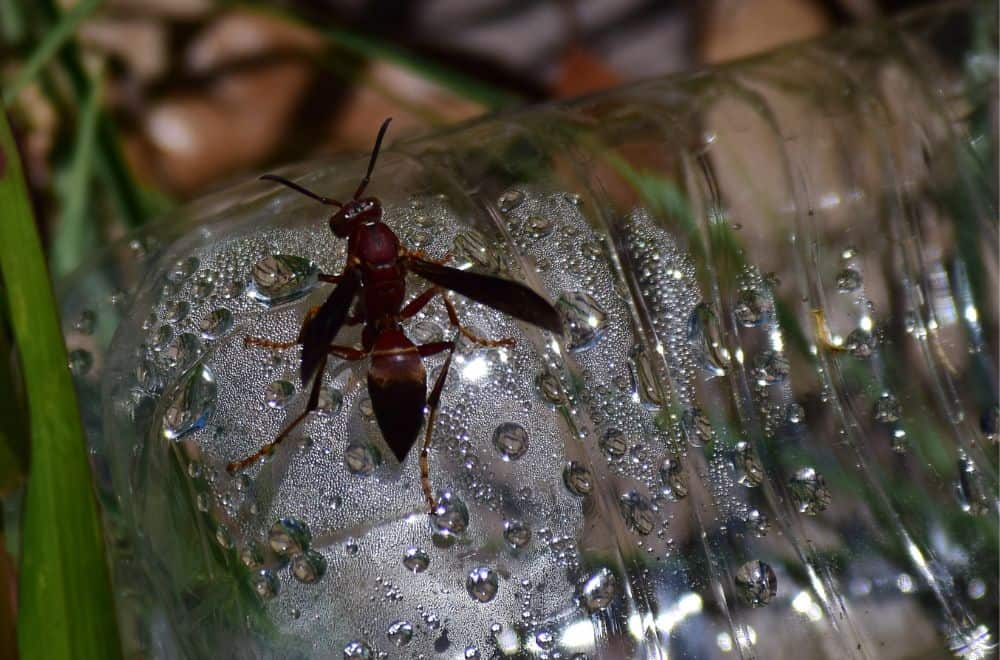
Besides wasp species that live without making a nest, it is impossible to see wasps in the loft without having their nests hidden or placed somewhere nearby. There are two possible options you should consider:
The nest is nearby
Wasp swarms sometimes occupy lofts but build their nests at other places. In such cases, they consider your attic an excellent food source and come there to feed on available sugar instead of their regular food, like:
- Aphid-produced honeydew
- Flower nectar
- The sugary liquid produced by their larvae
After a meal, they return to their nest placed nearby. Sometimes it is located in various places, including:
- Inside your home, often in the closet
- On a nearby tree in your garden
- Inside the bird box
- In your neighbor’s home or yard
- Inside outbuildings, like garages and sheds
- On the roof edges or under eaves
- In wall cavities
- In underground holes
Since wasps are potentially hazardous insects that bite, it is crucial to eliminate their nests immediately.
The nest is well-hidden
Another option is that wasps built their nest in your loft or on the porch but well-hid it. If your efforts to find it fails, the only option is to call professionals specialized in wasp pest control.
Wasp Nest Identification
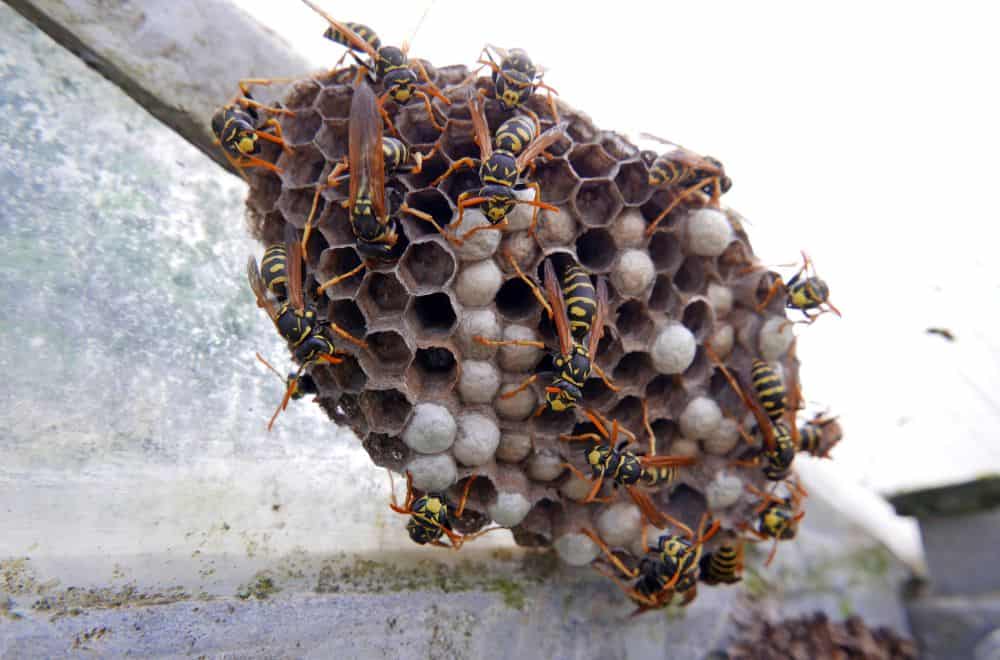
As mentioned, it is impossible to see a swarm of wasps flying around without the nest in the immediate vicinity. Since one mature nest contains thousands of insects during the summer, you should find and treat it on time.
Only that way can you reduce the threat of highly painful and potentially hazardous wasp bites. They may sometimes cause severe allergic reactions and jeopardize your health.
Identify the location
The first step is to identify the wasp nest, typically built inside hidden and protected spots with quick and free access to the outside. Be patient and carefully locate the wasp flight path.
Once-fed wasps immediately fly back to their nest in a straight line. Once you discover worker wasps’ fly direction, you will know where to look for their nest. You can speed up the process by offering them tinned fish or cat food. They will probably scoop it up and hurry to their nest.
The nest size
If you react in early spring when the Queen wasp starts building the nest, you will find a new-built, walnut-sized one in a hidden place. It will begin to collect bits of wood from garden furniture, shed walls, and fence panels, leaving tiny white lines on their surfaces.
Each nest has distinctive walls made of Queen wasp saliva and chewed wood pulp. Since an average balloon-like nest is grey or brown, you can hardly notice it when it is hidden inside a roof.
The nest’s size will grow with an increased number of new worker wasps and can become huge in the summer. Mature nests can reach a soccer ball size or sometimes become even more sizable.
Destroying such a nest can be pretty challenging and potentially dangerous since wasps are increasingly aggressive in the late summer.
The wasps’ reaction to the destroyed nest
Once you eliminate their nest, wasps will fly around until realizing that it doesn’t exist in the place anymore. After a while, they will randomly scatter, try to build a new nest, or join another wasp colony.
When to give up eliminating the nest?
Each nest contains hundreds or sometimes thousands of wasps, so you should be careful. For instance, never try to remove a wasp nest if you are sensitive to wasp stings and there is a chance of getting an allergic reaction.
Attempting to disturb a nest will immediately provoke wasps to defend it and attack the intruder. It is reasonable to expect at least a few stings in such a situation.
You should also consider letting wasps alone when they avoid invading your space. Since they are beneficial and reduce pest insects’ numbers, you can let them live without disturbance.
For instance, Jewel wasps lay eggs on roaches, and their larvae feed on their insides, killing these horrible pests. Adult wasps also catch aphids and black flies to feed larvae.
There is one more thing! Wasp colonies will die off in the fall, so the Queen will abandon the old nest and start looking for a comfy, protected place to hibernate. There is no point in destroying the nest when discovering it so late. Wasps won’t come back after using it for a year.
Best Ways to Eliminate Wasps and Their Nests in the Loft
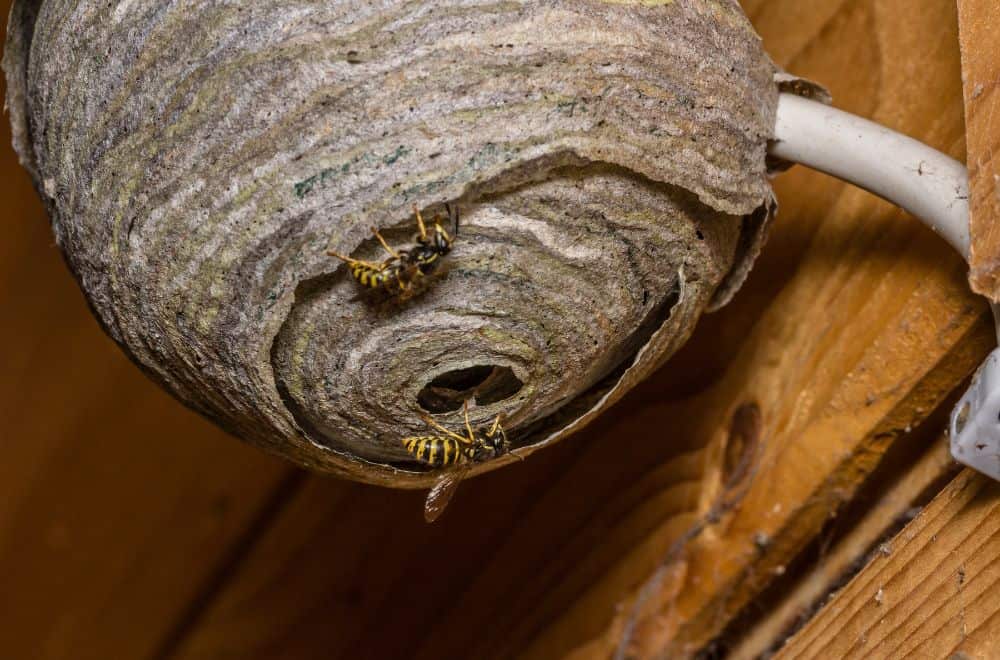
Since wasps can severely hurt you, it is necessary to be careful and well-prepared when destroying their nest.
- Gear up and carefully assess the situation
- Approach the nest and be caution
- Use safety equipment
- Kill wasps flying around the nest
- Check every entry point
- Destroy the nest and treat possible future nesting areas
You can apply a few proven methods to eliminating wasp nests in your loft. Let’s see.
Dish soap and water – This homemade method is environment-friendly and highly effective for small nests’ elimination. Dissolve two tablespoons of dish soap in water and pour the mix into a spray bottle. Spray it on the nest and let it kill wasps instantly after clogging their breathing pores.
Sprays – Buy a store-bought spray with a nozzle and apply it over an active nest in the evening when wasps are calm and less aggressive. This practical product will allow you to spray from a distance, preventing stings.
Commercial wasp traps – These products effectively eliminate wasps in your home. They contain a liquid that attracts insects and keep them stuck once they enter.
DIY traps – Make a wasp trap yourself by using a large soda bottle. Cut its top and add some fruit juice or soda on the bottom. Then, drip a few drops of dish liquid, invert the top, and hang the improvised trap at the wasp flying line in your yard.
Pesticides – If you have a wasp invasion inside your home, killing them with pesticides is an easy and quick solution. Always wait until the evening to apply a chosen chemical product to the nest. Insects are calmer at that time of day, decreasing the possibility of a massive attack.
Treat future nesting spots – Preventing wasps from nesting in your loft is always better than destroying existing nests. Assess which places might be suitable for wasps to build a nest and spray them with an efficient insecticide. That will discourage insects from future nest-building in your attic, under the roof, or patio.
Call professionals – Most experts specialized in wasp pest control can help you with their nest elimination. Besides, they can do an annual control and prevent these insects from occupying your loft.
Preventing Wasps from Re-entering Your Loft
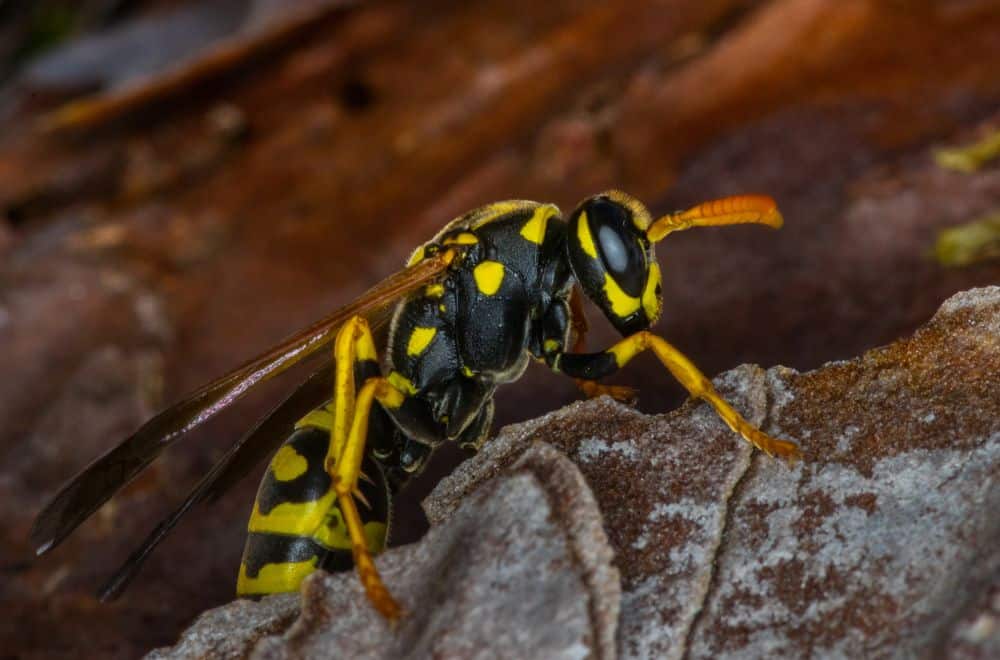
- Regularly inspect the loft for possible wasp nests
- Keep your entrances well-sealed and install screens
- Remove awnings
- Remove available food sources
- Properly dispose of waste, keep a trash can covered, and clean them weekly
- Cover ground holes and fill those existing in your home’s foundation
- Plant wasp-repellent flowers
- Seal wall cracks
How NOT to Remove a Wasp Nest?
There are three inappropriate ways to remove a wasp nest that can result in painful bites and endangered health. So, you should never use the following:
- An open flame and burn wasp nests
- A hose pipe to destroy wasp nests with a water jet
- Physical force and hitting wasp nests with a pole or baseball bat
Summary
It is sometimes possible to have wasps in your loft without seeing a nest. In such a case, you should know they are somewhere hidden and inaccessible. So, find the nest immediately and choose an appropriate way to eliminate it. Otherwise, you will face an unpleasant and potentially dangerous invasion.
